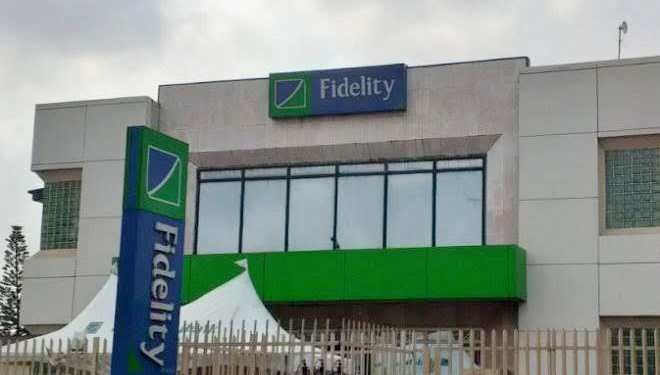With Efficient Growth of Its Net Interest Margin, Fidelity Bank Expands Profit Exponentially .

F i d e l i t y B a n k , in the first nine months of 2024 financial year , demonstrates the possibility of squeezing out water from a stone as it delivers exponential Profit amidst high interest and inflation rate -induced cost environment.
Fidelity Bank has demonstrated its 2024 financial year will once again be a harbinger of a juicier outing. With the release of the third quarter result for 2024 , all its performance metrics are practically looking up .Most importantly, its capability for managing risks—the risk of mismatches between assets and liabilities and between borrowing and lending rates that delivered whopping volume interest income that contributed over 90% of its gross earnings is yet unmatched by its peers .
The highly inspiring performance was a big surprise. The fact is that the competitive space has been paved with critical but hostile and hard policies, setting up the industry for failure .And no bank is immune from it .
First , with global markets locked into uncertainty caused by geopolitical tensions, supply chain reconstruction, and economic realignments, banks globally have had difficulties navigating the international and local business environments. Moreover , African banks have equally had to cope with foreign exchange volatility and worsening counter party conditions, while in Nigeria, banks have had to handle restrictive monetary policy as the Central Bank of Nigeria (CBN) tries to tackle raging domestic inflation .
Despite the inclement nature of the operating environment of the banking industry in which the players do their businesses,Fidelity still delivered superlative gains to its stakeholders. .
F i d e l i t y Bank has mastered the rope; it frustrated the above potential spoilers , exploited the available opportunities with dexterity and neutralized some threats to reatain its leadership of the Tier 2 banks in the financial industry .
How Fidelity Bank battled the above threats to exploit available opportunities also confirms the unusual pedigree of its leadership. To effectively compete, Fidelity Bank simply adjusted its internal strengths to the environmental opportunities.In the last few years ,its managers have demonstrated the capability to identify, combine, re-combine, and manage their resources and competencies . They explored the bank’s potential and performed competitively,focusing on the customer needs, preferences and desires satisfaction.
The positive impacts are clear enough. Fidelity Bank, Nigeria wrenched up bottom line with a deft application of management’s experience beginning from leveraging interest income to achieve that massive revenue .
The Pretax profit of this leading bank, buoyed by 153 percent in the period to to N281,4 billion from N111 billion. This helped to shoot up pretax profit margin to 36.4percent, up from 28.6 percent. with that rise in pretax profit, the bank’s net profit flew 144.8 percent to N224.6 billion from N91.8 billion in the period, leading to a rise in net profit margin to 29.1 percent from 23.6 percent.
The bank’s nine months result is another attempt to wring good profit as was done in the last financial of 2023 year, in its attempt to reaffirm leadership of the sector.
To cement its place as the most profitable bank, return on equity (ROE), improved to 53.3 per cent in 2024 from 26.6 per cent in 2023 This is as gross earnings increased by 98.7 per cent, to N772,465 billion in 2024 from N388 794 billion as at 2023
Well armed with iron teeth to break any macroeconomic the above hard nuts , Fidelity Bank, had its gross earnings increased in the third quarter of 2024 by a whopping 98.7% to N 772.5b from N388.8b in the corresponding period of 2023 .
The bank’s customer deposit rising by51.5% from N4.01trn to N6.1trn while its assets from N6.2trn hit N9.54 trn , an increase of 53.0% ; it delivered one best asset quality with non performing loan ratio at 2.8percent , and added maximum value to the operating community amidst severe macroeconomic and competitive challenges
.MATURITY TRANSFORMATION TO THE RESCUE
Behind this bank’s exploit is the strong strategic capability , huge and unique resources as well as its relevant core competencies , deployed to some critical income generating areas .With its assets supersonic growth by 53.0% as indicated above ,Fidelity Bank increased its earning assets heavily by37.6% from N3.09trn to N4 .25trn .
This decision may not be farfetched. Like other items in the balance sheet –capital ,reserves , investments ,etc ,the importance of loan portfolio derives from the functions lending performs for banks .The importance of loan portfolio derives from the functions lending performs for banks is ,no doubt ,very critical for its survival and success . Loan is ,for instance , is the highest earning asset in the balance sheet ; it contributes materially to the achievement and fulfillment of the objectives of profitability by providing higher return than other financial assets ; it helps the bank management to satisfy the legal and regulatory objectives of the monetary authorities ;‘it is a key element in the creation and maintenance of depositor relationships ,particularly with the business firms ; it is a vehicle through which management attempts to satisfy the credit needs of the community or the credit markets the bank serves or intends to serve
Although,the importance of lending in banking cannot be overemphasized as indicated above ,however, lending is mostly risky.. In fact, when it is said that one is a good or an astute banker ,what ,in fact , is meant is that one is a shrewd lender . –one who lends money safely and profitably . Sequel to this ,all the technical training a banker receives is heavily geared towards lending .One of the risks that is associated with lending is interest rate which features in the spread or the difference between the rates at which the funds are borrowed and the rate at which they are invested or loaned out –the risk of mismatches between assets and liabilities and between borrowing and lending rates . Apart from the interest risk , there is also the risk of default or credit risk .In the period under review , Fidelity Bank, no doubt ,lent out highly profitably and safely than ever .
By hauling up net interest income by et Interest Income by 141.3% from N 194.96b to N470.49b Fidelity Bank showed that it’s has what it takes to prevail on the interest rate risk despite the fact that Monetary Policy Rate had hit the rooftop A critical analysis of its interest income it took the bank N33.30 to generate N100,thereby contributing N67 to the net interest income .This is, no doubt , one of the industry best that is confirmed by the of its net interest margin from 8.1 percent to 11.9 percent
By this, interest income alone took care of 91.4 percent of its gross revenue at N706.7b as against its gross revenue of N772.5b ; in the corresponding period of 2023 it was 83.6 percent at N306.6b against its gross revenue of N388.8b
However , while the bank its interest income grew faster by 117.6 percent compared to its interest expenses that grew at slower at 81 to boost its revenue, a potential spoiler came in as its credit loss rose to N48.25b in 2024 ,an increase of 49.9 percent against N32.18b.
But the leadership of Fidelity Bank proved to be smarter. It knocked out the negative impact of the provision for its credit loss with some items from its non interest income segment. Its fee and income grew at a faster pace at 189percent from N56.3b to N162.8b compared to its fee expenses which by87.8 percent from N5.14b to N9.65b Other operating income also grew by 163 percent from N10.47b to N27.54b
Another threat to the bottom line came from the net gains from financial assets at fair value through profit or loss which decreased 45percent from N34.99b to N19.20b
The bank’s superior strategic capability in cost optimization is another feature in the last nine months of 2024 that further strengthened its bottom line. Its operating income grew at a faster pace at 130.3% from N143.17b to N329.67b in 2024 compared to its operating expenses at 89.5% . from N125.31b to N237.43b .
Similarly, the bank’s total assets grew by 53 per cent, from N6.2 trillion in the preceding year to N9.5 trillion in 2024 ; while shareholders’ fund grew marginally by 57.4 per cent, from N437.3 billion in 2023 to N688.3 billion in 20e4 .
For such weighty shareholders’ fund, it is natural to pull in heft deposits as total customers deposits grew 51 5 percent to N6.08 trillion from N4.01 trillion.
But it was the bank’s ability to meet and surpass regulatory guidlines that was the highlight of the full year results. Interest expenses moved at a slower pace than interest income were managed down as the bank’s stock of low cost deposits increased, with interest paid on time deposits declining .. Also, the cost of risk dropped to 1.8 per cent as against 2.6 . per cent in 2023 .
The bank’s balance sheet was robust as the liquidity ratio and capital adequacy ratio were 63.4 per cent and 19.3 per cent respectively, all well above the regulatory threshold.
Also, the bank’s robust risk management framework ensured that the cost of risk reduced significantly from 2.6 per cent in the prior year to 1.8 per cent in 2024 . This was achieved despite increase in i impairment charges, re-affirming the bank’s enhanced asset quality. In the same breadth, non performing loan ratio ratio came down to 2.8 per cent from 3.5 percent over the same period, an indication of prudent disposition consistent with the bank’s known record ofexcellent credit risk management.
As a result of the significant improvement in efficiency, the bank’s cost- to-income ratio settled at 41.9 per cent from 50.4 per cent in 2023 .
The bank’s customer deposits grew by 51.5 9 per cent with Domiciliary contributing 51.3 percent of the total deposits of N6.08 trn ,; Demand deposits , 24.6 percent, saving deposits, 17.2 percent; term deposits, 5.1 percent and others , 1.9 percent.
However, term deposits delivered the biggest increase at 308 percent followed by other deposits by 293.5 percent and Domiciliary at 126.8 percent. Its savings deposits increased by 18.5 percent while its demand deposits grew by 9..6 percent , . providing it with a platform to rebalance its deposits mix.
In 2024 , the costly deposits were foregone in favour of cheaper and more stable deposits resulting in a reduction of expensive and shorter dated deposits .
This culminated in the reduction of cost of funds which declined for the year. The results were a testament of the bank’s efforts to deepen its roots in the retail segment. This has led, in the main, to a remarkable increase in the volume of transactions across various electronic platforms as well as significant customer acquisitions. This growth in transactions on the bank’s digital channels continues to support the bank’s retail push as fees from e-products increased with retail deposit balances also growin. The bank also stated that it would continue its nvestment in the retail end of the market to consolidate its leadership in both the corporate and retail segments.
The bank has assured shareholders of the bank’s commitment of continuing to deliver superior returns in the years ahead. Fidelity Bank remains a clear leader in the digital space, with several firsts in the deployment of innovative products, solutions and an assortment of alternative channels that ensure convenience, speed and safety o transactions.
“To continue to cater to the varied appetites of our customers in a constantly changing world and stay ahead of the competition, therefore, we have invested massively in new technologies and innovative solutions in the last financial year. This is geared towards ensuring that we continue to provide best in class quality services that create value for all our stakeholders,” he said, noting that Fidelity Bank made significant progress in the adoption and integration of sustainable banking principles into its business, especially in its credit administration process.
e
Corporate Governance Rating System (CGRS) and compliance.




